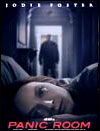 Panic
Room Is In the House!
Panic
Room Is In the House! Panic
Room Is In the House!
Panic
Room Is In the House!The best thing I can say about Panic Room, the new thriller starring Jodie Foster, is that it answered all of the questions I had after watching the trailer. OK, that's not the best thing I can say ... er, write. The best thing about Panic Room is what a tense, effective, well-crafted nail biter it is. I'm in dire need of manicure after seeing it. The sledgehammer scene alone had me gnawing through thumb and forefinger.
But the thing that really distinguishes Panic Room is the quiet, disturbing logic with which the movie's plot unfolds, twists, turns, and gradually resolves itself. Like I said, I had a lot of questions after seeing the trailer for the film earlier this month. It was one of those previews that expertly set up the premise and plot of the film, but raised a whole bunch of logic questions. Foster plays Meg Altman, a divorced mother of an androgynous boy-girl (Kristin Stewart), who buys a New York brownstone and discovers it has an elaborate panic room built into the third floor. Panic rooms are high-tech sanctuaries that a home's occupants--usually the very wealthy--can hide in should the house be invaded by burglars or some other unfortunate incident should occur.
On their first night in the house, the Altmans are startled by three crooks (Forest Whitaker, Jared Leto, and Dwight Yoakam) who have broken in and are looking to steal millions hidden somewhere inside. Meg and her daughter-son barely make it into the panic room. Soon, though, they discover that what the robbers are after is IN the panic room.
My questions before I saw the film ranged from: "Why doesn't Jodie just call the cops from the panic room?" to "Why do the crooks just leave and come back some other time?" to "Why would mother and child dare leave the panic room, as shown in several scenes?" to "If Jodie can watch the crooks via TV monitors, why don't they just tear down the various cameras placed throughout the house?" The ease with which director David Fincher and screenwriter David Koepp answer these questions, then raise new ones, then answer them is one of the things I loved most about their movie.
Yup, you heard the name. David Fincher. He's that same twisted soul who brought us Seven (the greatest serial killer film ever made), The Game (mesmerizing until it fell apart at the end), and Fight Club (still a great mind-screw). I knew I was gonna be in for some dark twists with this one. While there is nothing like Gwyneth's head in a box or Ed Norton's split personality, we do get some deliciously tense moments in Panic Room. The best involve Meg's attempts to retrieve a cell phone she left charging on her nightstand and the wonderful moment when two of the crooks get locked into the panic room ... WITH Meg's son-daughter!
(Sorry, I'll stop referring to her as such. For an 11-year-old, Kristen
Stewart actually gives quite a remarkable performance as
the DAUGHTER. It just took me half the film to figure out the kid's
gender. But, hey, that's just me and my white Wonder Bread
suburban upbringing. It's all good.)
The film works because much of the twists emerge from the characters' personalities--their strengths, their weaknesses, their ability or inability to think fast on the run. In particular, the three crooks are an interesting case study in greed, compassion, incompetence, intelligence, hate and despair. Whitaker plays Burnham, who works for the company that designed Meg's panic room. Leto is Junior, the disgruntled heir to the dead millionaire who previously owned the house. And Yoakam shines as Raoul, a homicidal loose cannon with little regard for anyone's life but his own. The trio don't really know each other. They are a partnership of convenience, not experience. But more than that, they thought the house would be empty and the job simple. Only Raoul has no problem killing the mother and daughter. Burnham and Junior just want the cash.
Domestic thrillers, when done well, reach us on a deeper level. Anyone who has ever been alone in a house at night has at one time or another been scared that someone might be at the window, or the backdoor, or on the front porch. Panic Room does a good job at putting you in the characters' predicament, even the criminals. And Fincher uses every trick at his disposal, from odd camera angles to multiple perspectives to digital trickery (the break-in sequence is just a marvel of cutting-edge cinematography and CGI effects), to ratchet up the tension while always giving us a clear idea of what is going on and where inside and outside the house.
The most interesting thing about Panic Room is that it's not so much about the criminals' attempts to force their way into the panic room, but their efforts to get Meg and Sarah to come out. What will you need to get into the Panic Room? Just the cash for a movie ticket. Then, sit back and enjoy ... oh, and bring a nail file and some clippers. You'll need 'em.
Panic Room is rated R for violence and language.
[Home]